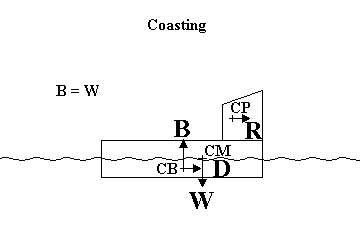
| Raingutter Boat Racing - | Breathing Life Into Your Boat |
How long does it take for your boat to slow down from near terminal velocity, vt when you stop blowing on it? The analysis is similar to the one for the accelerating boat, but this time the blowing force, F, is zero. Now there is nothing to keep the the hull drag, D, and the air resistance on the sail, R, from making the boat coast to a complete stop. How far will it go before it stops?
Mathematical models use mathematical notation. The various environmental, structural and performance factors are written using short one or two letter symbols. Each factor also has physical units that relate to physical measurements that might be measured given appropriate instruments when possible. The table below presents the notations of the factors modeled.
| Symbol | Units | Description |
|---|---|---|
| S | in2 | Area of sail |
| B | in/s | Velocity of breath hitting sail |
| R | oz | Force of air on front of sail resisting motion |
| e | scalar | Drag coefficient of front of sail |
| D | oz | Force of water on hull resisting motion |
| q | scalar | Drag coefficient of hull below the waterline |
| m | ozs2/in | Mass of the boat |
| v0 | in/s | Initial velocity of boat |
| L | in | Length of raingutter |
| p | ozs2/in4 | Mass-density of water |
| pa | ozs2/in4 | Mass-density of air |
| g | in/s2 | Acceleration by gravity |

The deceleration of a boat can be modeled using the general model for a vehicle undergoing attenuated motion. The equation of motion can be written grossly as,
ma = - D - R
This is not a balance equation. Hull drag and sail resistance depend on the existence of the driving force that accelerates the boat and soon reduce to zero when it is absent.
The force of friction due to hull drag is caused by pressure drag in the water. It is important to note that this model is only useful down to a certain speed at which the motion of the boat is essentially arrested. This is because the mathematics express an ever slowing but never terminating motion! (This is the type of process I tend to associate with the prospect of "eternal death" in Hell; the antithesis of "eternal life" in Jesus' presence.) We write
D = qpAv2/2 where q is the pressure drag coefficient, p is the water density, A is the frontal cross-section area of the hull below the water line and v is the speed of the boat.
The force on the sail is zero, since blowing has ceased.
As the boat slows down, air continues to resist the movement of the boat.
R = epaSv2/2 epaSv2/2 where e is the pressure drag coefficient, pa is the air density, S is the front cross-sectional area of the sail (its lower edge is assumed to be very near the water line) and v is the speed of the air which is the speed of the boat.
Putting these together with the signs of slowing force terms made negative we get:
Force = Sail Force - Frictional Forces
Air Water
ma = 0 - epaSv2/2 - qpAv2/2
Group the drag and resistance terms to isolate v.
ma = - (qpA+epaS)v2/2
We can now make the proper mapping between the physical factors of this model and those of the general one in the following table.
| General Model | This Model |
|---|---|
| M | m |
| k | (qpA+epaS)/2 |
| v0 | v0 |
| L | L |
| t | t |
Using this map we can apply the general model results to this specific model without having to derive the expressions all over again. Instead, the general model expressions are rewritten using the corresponding expression noted in the map table above. Then the expressions are simplified a bit to give the specific expressions we seek for this model. If any additional expressions are needed for this model, they are derived below.
The various factors above are related to one another using physical laws and analysis. Some of these relationships have special meaning in understanding the model. These as well as kinematic factors (like time, acceleration, speed and distance) are recorded in the next table as a summary of the model.
| Description | Units | Expression |
|---|---|---|
| Equations of Motion | oz | ma = - qpAv2/2 - epaSv2/2 |
| Displacement Distance | in | Y = 2m/(qpA+epaS) |
| Initial Velocity | in/s | v0 = vt \[1-exp(-2(y+y0)/Y)] from acceleration model v(y) |
| Momentum Transfer | ozs/in | P = v0(qpA+epaS)/2 |
| Displacement Time | s | T = t0 = m/P |
| Time | s | t(y) = T exp(y/Y) - t0 |
| Velocity | in/s | v(y) = v0 exp(-y/Y) |
| Velocity | in/s | v(t) = v0/((t+t0)/T) |
| Distance | in | y(t) = Y ln((t+t0)/T) |
| Acceleration | in/s2 | a(t) = - (qpA+epaS)v02/2m((t+t0)/T)2 |
| [Dry Dock] | [Title Page] |
| Raingutter Boat Racing - | Breathing Life Into Your Boat |
| Copyright © 1997, 2000, 2002, 2004 by Michael Lastufka, All rights reserved worldwide. | |